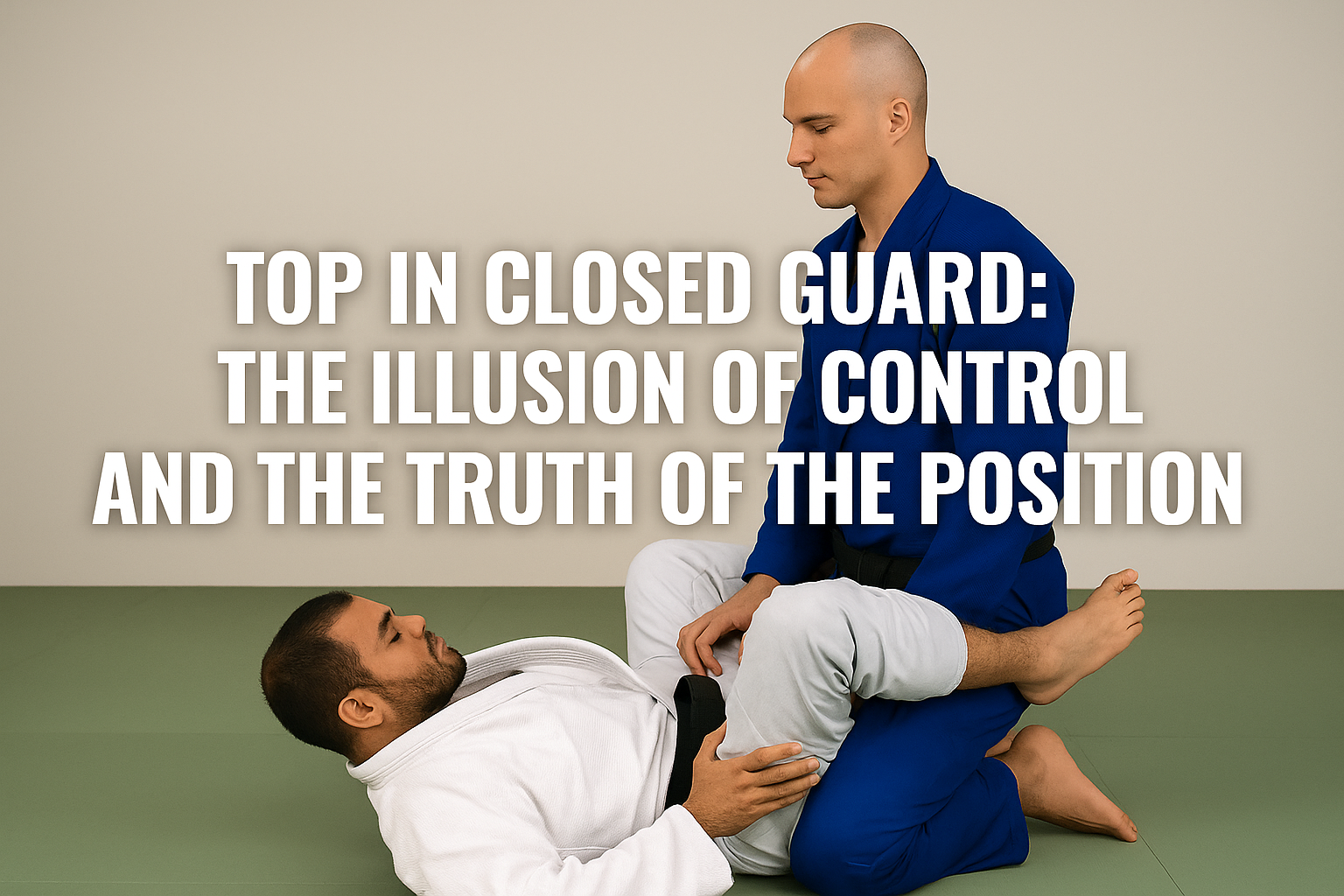Top in Closed Guard: The Illusion of Control and the Truth of the Position

Most new grapplers make the same mistake. They believe that being on top means being in control. You are above your opponent. You can use your weight. You feel balanced. But inside closed guard, that confidence is an illusion.
Closed guard is one of the few positions in Jiu-Jitsu where the person on the bottom has the upper hand if the top player does not know what they are doing. The bottom player has mobility, leverage, and control of the hips. The top player is stuck in a tight frame of tension, and one small mistake can lead to a sweep, a submission, or a scramble they cannot win.
If you want to be more than just the person who “gets on top,” you need to understand what this position truly is. It is not a dominant position. It is a tactical trap. And it is your job to defuse it.
What Is the Closed Guard from the Top?
In closed guard, your opponent wraps their legs around your waist and locks their ankles behind your back. They can use their legs to pull you, control your hips, and set up submissions or sweeps. You are in a locked frame. Your mobility is restricted. Your arms and posture are exposed.
From the top, you are physically above them, but you are not in a dominant position. You are in a neutral position with a time limit. The longer you stay there without making progress, the more opportunities your opponent has to break you down.
You cannot win this position by stalling or powering through. You win it by understanding what is required: posture, guard breaking, and controlled passing.
Why This Position Is Misunderstood
New students associate the top with control and progress. Closed guard flips that concept upside down. You are not in mount. You are not in side control. You are in someone’s weaponized grip.
If you do not know how to handle this position, you are a guest in someone else’s house, and you are one invitation away from being kicked out.
Experienced grapplers do not relax in closed guard. They respect it. They work to get out of it quickly and efficiently, and they know that even one slip in posture can cost them the entire round.
The Pros of Being on Top in Closed Guard
There are benefits to being on top in this position, but only if you understand how to use them:
- You have gravity
You can use your body weight to apply pressure, slow down their movement, and tire out their core. - You have the opportunity to pass
Once you open the guard, you are in prime position to transition into side control, mount, or another dominant spot. - You control the tempo
When you keep your posture and deny grips, you can force the bottom player to react instead of attack. - You get a better view
From the top, you can see your opponent’s setup and read their intention earlier than they can see yours.
The Cons and Risks of Being on Top
This is not a place to be lazy. It is a position with built-in risks:
- Your posture is the first target
If you lean forward or let your spine round, you are opening yourself to collar chokes, arm drags, and submissions. - Your arms are exposed
One extended arm and you are in an armbar. One cross grip and you are in a triangle. One hand on the mat and you are in trouble. - Sweeps are waiting
A well-timed hip bump or flower sweep will flip the round in seconds. If your base is off, you are going for a ride. - Mental traps are real
Many top players stall out. They stop trying to pass. They pause and hope the bottom player will make a mistake. But inactivity is the biggest mistake.
Your Three-Part Job from the Top
There are only three things you need to focus on when you are on top in closed guard.
1. Posture
This is your armor. No posture means no defense, no offense, and no balance.
- Sit tall with your hips slightly back
- Keep your back straight and your chin tucked
- Keep your elbows close to your ribs
- Do not place your hands on the mat
If you keep your structure, you deny your opponent the tools they need to attack.
2. Break the Guard
You cannot pass until the legs are open. Your opponent knows this, so they will keep them locked as long as possible.
Break it with:
- Knee in tailbone
Frame on their hips. Drop one knee to the center. Step the other leg wide and apply steady pressure backward. - Standing break
Control the lapel or belt. Stand up one leg at a time. Keep your spine tall. When they open, push the legs down and begin passing. - Hip press break
Use your forearms to pin their hips while backing away slowly. Spread their knees until the ankles give out.
Each break requires balance and pressure. If you rush, you fall. If you hesitate, they attack.
3. Pass with Control
After breaking the guard, do not sprint. Control the hips. Set your grips. Choose your pass.
Effective passes include:
- Knee cut
- Over-under
- Bullfighter pass
- Body lock pass
Use the right one for the moment. Use the pass that gives you control over the hips and limits their frames.
What to Avoid on Top
Avoid these common errors:
- Leaning too far forward
- Reaching with one arm
- Placing hands on the mat
- Standing without grip control
- Rushing without balance
- Holding your breath or tensing up
These mistakes do not just lead to submissions. They lead to poor habits. And poor habits get punished fast in closed guard.
Mindset Shift for the Top Position
Top closed guard is not about dominance. It is about dismantling a frame. You are not in control unless your opponent has nothing left to work with.
Your mindset should be clear:
- Strip their grips
- Deny their angles
- Break their posture
- Keep yours intact
- Turn patience into progress
You are not trying to beat them in closed guard. You are trying to break out of it so you can beat them elsewhere.
Checklist for Every Time You Are on Top
Use this checklist mid-roll to stay sharp:
- Are your hips slightly back?
- Is your spine straight and upright?
- Are your elbows close to your body?
- Are your hands safe from the mat and submissions?
- Are you denying grips before attempting to break the guard?
- Are you breathing calmly and moving with purpose?
This checklist turns chaos into clarity. Use it until it becomes automatic.
Train This with Intention
The next time you train, ask your partner to close guard. Your goal is to stay postured for two full minutes. No passing. No submissions. Just survive with perfect structure.
Switch roles.
You will discover how much your posture matters. You will feel when it starts to break. You will learn what true balance feels like. And from there, your passing game will improve without adding a single new technique.
